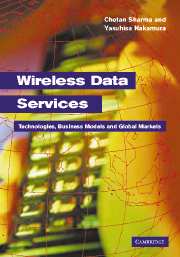Book contents
- Frontmatter
- Contents
- List of figures
- About the authors
- Foreword
- Acknowledgements
- List of abbreviations
- 1 Introduction
- 2 The impact of globalization
- 3 Adoption trends and analysis by region
- 4 Subscriber needs and expectations
- 5 The wireless value chain
- 6 Global wireless technologies: systems and architectures
- 7 Global wireless technologies: network, access, and software
- 8 Business models and strategies
- 9 Business issues and challenges
- 10 Technology issues and challenges
- 11 Case studies
- 12 Perspectives
- 13 Future of wireless technologies, applications and services
- 14 Conclusions and recommendations
- References and recommended reading
- Index
7 - Global wireless technologies: network, access, and software
Published online by Cambridge University Press: 06 August 2009
- Frontmatter
- Contents
- List of figures
- About the authors
- Foreword
- Acknowledgements
- List of abbreviations
- 1 Introduction
- 2 The impact of globalization
- 3 Adoption trends and analysis by region
- 4 Subscriber needs and expectations
- 5 The wireless value chain
- 6 Global wireless technologies: systems and architectures
- 7 Global wireless technologies: network, access, and software
- 8 Business models and strategies
- 9 Business issues and challenges
- 10 Technology issues and challenges
- 11 Case studies
- 12 Perspectives
- 13 Future of wireless technologies, applications and services
- 14 Conclusions and recommendations
- References and recommended reading
- Index
Summary
Network and access technologies
In Chapter 6 we discussed various cellular systems around the world and what kind of evolution strategies carriers are likely to be adopting in the next few years. In this chapter we will discuss the key network and access technologies and software technologies impacting on the wireless world. We will first take a look at the wireless network architecture and then discuss various wireless WAN, LAN and PAN technologies. This discussion is presented to make the reader familiar with the spectrum of wireless technologies. For a more comprehensive discussion, please refer to the References, where we have listed some useful texts for detailed technological discussions.
Position location
In 1996, the FCC in the USA, via a series of orders, had mandated all wireless carriers to provide automatic location identification (ALI) as part of phase II E911 (Enhanced 911 for emergency services), with the implementation starting on 1 October 2001. In the past four years or so, the FCC has adjusted the requirements to better suit the reality of position-location solutions. These solutions can be broadly divided into two main categories: network based and handset based. Techniques such as Angle of Arrival (AOA), Time Difference of Arrival (TDOA), and MultiPath Fingerprinting (MPF) are the commonly used network-based solutions, while GPS or network-assisted GPS are the primary handset-based solutions. Both solutions have their advantages and disadvantages, short-term and long-term.
- Type
- Chapter
- Information
- Wireless Data ServicesTechnologies, Business Models and Global Markets, pp. 124 - 158Publisher: Cambridge University PressPrint publication year: 2003

